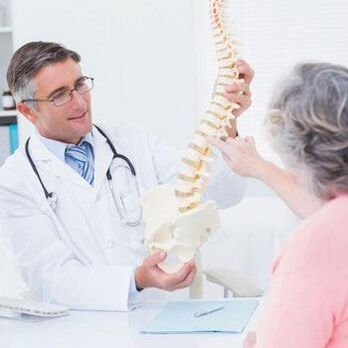
As you know, one of the most common and dangerous pathologies that can disrupt the functioning of internal organs and worsen motor activity is osteochondrosis of the thoracic region. If a person is diagnosed with this disease, and he does not take timely action, this is concerned with the occurrence of severe pain manifestations, cardiovascular system dysfunction, gastrointestinal tract deterioration, development of inflammatory processes in the respiratory system, lack of reproductive functionand other serious complications.
In this article, we will give detailed information about thoracic osteochondrosis and talk about the main points associated with the development of this disease. You will also learn about risk factors, effective treatment measures, and possible negative consequences. We hope the material proposed will be useful to you.
What is osteochondrosis of the thoracic spine
<2_img_rightxx>According to statistics, osteochondrosis of the thoracic spine can be observed in different people, regardless of sex and age. If the disease manifests itself in children, their musculoskeletal system is subject to premature aging.
What is this disease we hear so often about? This is one of the dangerous pathologies, which is accompanied by degenerative-dystrophic changes in the area of bones and cartilage. Lack of timely treatment is fraught with destructive processes that affect the joints, intervertebral discs and ligaments.
Frequently, in the context of thoracic osteochondrosis, the following pathological processes can occur: impaired reproductive function; pathological replacement of lung tissue by connective tissue; cancer neoplasms; inflammatory lesions of the prostate; atherosclerosis, etc.
It should be noted that in the early stage of the disease, pathological changes mainly affect the bones, but gradually the disease spreads to muscle, connective, and cartilage tissue.
Stages of development of osteochondrosis of the thoracic region
At present, 4 stages of the pathological process are known:
Causes of Thoracic Spinal Osteochondrosis
There are several known risk factors that can cause the disease to progress:

- genetic predisposition;
- Hypodynamics;
- Scoliosis;
- Regular lifting of heavy objects;
- Injury in the thoracic region;
- Wear high-heeled shoes during pregnancy;
- Alcohol and tobacco abuse;
- Deterioration of blood flow in the spinal cord area;
- Significant physical activity;
- Exposure to thermal factors;
- Bone tissue dystrophy;
- The presence of a herniated disc;
- Obesity;
- Disturbance of metabolic processes;
- Cartilage destruction.
Symptoms of osteochondrosis of the thoracic spine in men and women
It is important to note that the disease described above is also characterized by an alteration in the composition of cartilage tissues. This pathological process is accompanied by the following manifestations:
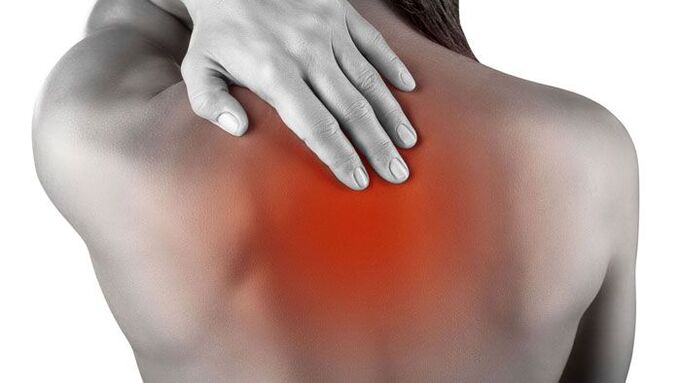
- A feeling of tightness in the chest area, which is accompanied by a deterioration in the activity of the respiratory system;
- Regular numbness of limbs;
- The appearance of noticeable discomfort when turning the body;
- Loss of sensation in the limbs;
- Brittle nails;
- Presence of tooth in the region of the hands;
- Digestive system malfunction;
- Reproductive dysfunction;
- Painful manifestations in the head region, which are regular;
- Vomiting, nausea and heartburn;
- Defeat of the intercostal nerves, accompanied by acute pain syndrome (neuralgia);
- Pain in the abdominal region;
- Significant discomfort on the left side of the chest;
- Right chest pain syndrome;
- Tachycardia;
- Increased sweating.
Signs characteristic of the subacute phase
It makes itself felt after a period of exacerbation. Manifestations of pain and respiratory system dysfunction remain, but are less intense. The patient stops looking for a position to eliminate the discomfort. The duration of the subacute phase is up to 12-14 days. With strict adherence to expert advice, remission is possible, with characteristic attenuation of pronounced signs. Failure to follow the recommendations may lead to repeated exacerbation of the disease.
Remission of osteochondrosis of the thoracic spine
This phase is characterized by a temporary improvement in the patient's condition. In this case, discomfort may return - in case of exposure to thermal irritants or changes in weather conditions. Acute pain syndrome is felt exclusively with 2 to 4 degree thoracic osteochondrosis - due to a sudden change in body position. Excessive physical exertion, stressful situations, chronic illnesses in the acute phase, and an immobile lifestyle can also cause a relapse.
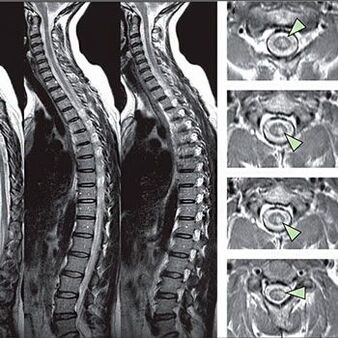
Methods for diagnosing osteochondrosis of the thoracic spine
For a clear diagnosis, the specialist must take the patient's complaints into account. The following symptoms and sensations in women allow detecting thoracic osteochondrosis: when pressing certain points in the chest region, a strong pain syndrome appears.
To identify signs of impaired sensitivity, special functional tests are performed. The most informative diagnostic option of instrumental methods is the X-ray. However, MRI and CT scans are often done to completely examine the spine. If you suspect diseases of the cardiovascular system, the patient should have an ECG procedure.
First Aid for Acute Thoracic Spinal Osteochondrosis

Pain manifestations during the period of disease recurrence are characterized by an acute and penetrating character, which implies the provision of emergency care to the patient. It should be placed on a flat surface, covered with a warm blanket. If anxiety, shortness of breath or tachycardia appear during a relapse, a specialist should be called immediately. To relieve pain in the intercostal region, the use of non-steroidal anti-inflammatory drugs is recommended.
Treatment of Thoracic Spinal Osteochondrosis
To understand the best way to treat osteochondrosis of the thoracic region, one must remember the fundamentals of a comprehensive technique. Within its scope, several therapeutic measures are implemented simultaneously, making it possible to deal with almost all signs of pathology. With an initial illness, conservative therapy is used. With more advanced stages of the pathological process and the presence of a herniated disc, surgical intervention may be necessary to eliminate the compression syndrome.
physiotherapeutic treatment
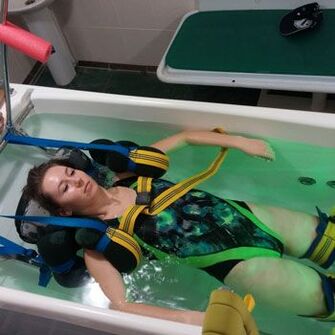
To understand how to treat osteochondrosis of the thoracic spine with physical therapy methods, you must remember its mechanism. Therefore, the most effective ones in identifying the above pathology are:
- Exposure to the body with constant electrical current with simultaneous use of drugs;
- Methods associated with using a static magnetic field;
- Phonophoresis;
- Ultrasound therapy;
- Hydrotherapy and underwater spinal traction.
SWT for thoracic osteochondrosis
Shockwave therapy is considered to be one of the most effective ways to restore the affected parts of the spine. This physical therapy method is based on the effect of acoustic impulses on the areas affected by the destructive-degenerative process.
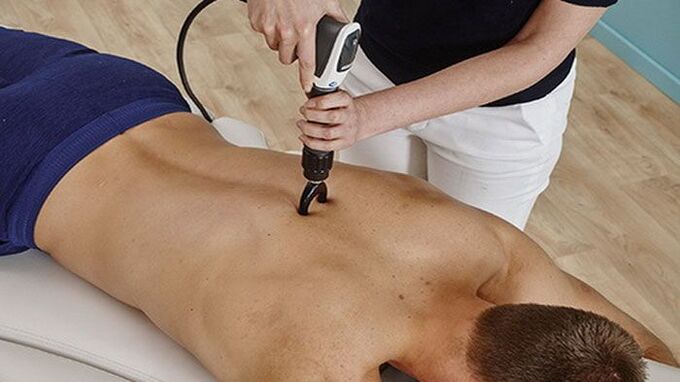
In this case, special medical equipment is used. By converting electrical impulses into shock waves, you can quickly deal with salt deposits, reduce the size of osteophytes, and minimize pain intensity.
As a rule, the procedure is effective in the presence of cervical, thoracic and lumbar osteochondrosis. Its main objective is to restore the normal condition of the joints, bones and cartilages, as well as to increase the elasticity of the affected vertebrae. Furthermore, due to the impact of shock waves, it is possible to activate the development of new blood vessels and improve the blood supply to the muscles.
Acupuncture
This technique involves introducing small diameter needles into biologically active points. To activate a positive effect, they are rotated around an axis or subjected to heating. With the help of acupuncture, you can quickly stop the pain syndrome, eliminate inflammatory and congestive manifestations, deal with swelling, relieve spasm, restore normal blood flow, and improve mobility.
Pharmacopuncture
The method of administering medication through reflex points. In this case, drugs are injected into the lesion.

Taking into account the intended purpose, the following drugs are used:
- Means to reduce skeletal muscle tone and restore mobility to the vertebrae;
- Medicines with analgesic and anti-inflammatory effects;
- Medicines that reduce muscle tone and dilate blood vessels;
- Preparations that accelerate recovery and metabolic processes;
- Vitamin complexes that contribute to the normalization of cellular nutrition and improve the functioning of the immune system;
- Homeopathic remedies to normalize the immune and musculoskeletal system.
Massage for osteochondrosis of the thoracic spine
It should be noted that massage in this department can be performed even in an acute period. Through it, it is possible to restore blood flow, improve the state of muscles and normalize their functionality, in addition to minimizing the load on the vessel that supplies the brain.
Use of medications
<10_img_rightxx>If we talk about how to treat thoracic osteochondrosis with medication, then we must first take into account the degree of the disease, the nature of its onset and the intensity of the pain syndrome. Most of the time, the following medications are used:
- Funds from non-steroidal groups. They are drugs with an anti-inflammatory analgesic effect, which it is advisable to use during the course, at the end of which they are transferred to special ointments;
- Anesthetic drugs. They have an analgesic effect. Used as an intravenous drip;
- Diuretics. Allows you to deal with swelling, eliminate signs of pathology, have a beneficial effect on the state of the myocardium;
- Medicines that reduce skeletal muscle tone, restore mobility to the vertebrae, and relieve pain.
In some situations, the patient is recommended to use hormonal drugs, anticonvulsants, vitamin complexes, drugs to restore the condition of blood vessels and sedatives.
Injections for osteochondrosis of the thoracic spine
Patients are often interested in knowing what to do with thoracic osteochondrosis if it is accompanied by acute onset of pain. In order to provide a quicker effect on the nerve endings, they resort to spinal injections. In this case, anesthetics and glucocorticosteroids are used. After normalizing the patient's condition, they start using gels and ointments.
Gymnastics for thoracic spine with osteochondrosis
Before performing exercises for the thoracic spine with osteochondrosis, it is recommended to do a warm-up that provides the necessary muscle warm-up and increases the effectiveness of future training. You can also take a shower and give a light spinal massage in the thoracic region.

Warming up is of particular importance for those patients who perform gymnastics with thoracic osteochondrosis at home for the first time. As part of the preliminary warm-up of the muscles, the following movements can be performed: turns and rotations of the pelvis and neck, rhythmic movements of the limbs, performed in different directions (swing). It should be remembered that gymnastics for thoracic osteochondrosis is performed without haste and gently. If exercise is associated with acute pain syndrome, it is better to decline.
At the moment, thoracic spine gymnastics, recommended for osteochondrosis, involves performing 6 basic exercises:
Diet for Thoracic Osteochondrosis
According to the expert, it is better for people who suffer from this disease to exclude fatty foods, smoked foods, marinades and preservatives from the diet. You should also reduce the amount of salt as it can cause severe swelling. In addition, the amount of fluid consumed should not be less than 2–2. 5 liters per day.
Surgical intervention
Depending on the clinical manifestations of thoracic osteochondrosis, specialists select the appropriate treatment. In advanced cases, surgical intervention is performed, within the framework of which:
- Intervertebral disc excision;
- Removal of a herniated disc;
- Surgical intervention for spinal stenosis;
- Disk replacement.
Traditional Methods of Treatment of Thoracic Spinal Osteochondrosis
As a rule, traditional medicine methods are considered relevant after completion of the main therapy. In that case, herbal infusions and decoctions, compresses, various ointments and gels can be used. Basically, these resources are used to relieve low intensity painful manifestations, which are felt after physical exertion. The following recipes are most commonly used:

- Peel, grind and squeeze the celery root juice. The resulting raw material is mixed with celery. The main purpose of this tool is to combat salt deposits in the spine;
- The dried roots of the sunflower are crushed and hot water is added to the mixture. Cook over low heat for about 15 minutes, then insist and filter. Take 3 times throughout the day.
Medicinal during pregnancy
It should be remembered that most anesthetics are not allowed during pregnancy. Neurologists recommend limiting your intake of gels, ointments and patches. In most cases, if a pregnant woman is diagnosed with osteochondrosis of the thoracic region, the treatment is reduced to physical therapy exercises and massage, whose positive effect is evidencedpeople results. . .
<13_img_rightxx>Possible complications
If a patient is diagnosed with thoracic osteochondrosis, but he has not taken timely action, this can lead to gastrointestinal tract dysfunction, inflammation of the respiratory system, violation of heart rhythm, as well as deterioration of reproductive function.
In case of significant compression of the nerve endings, they can be felt:
- Pathological processes in the area of the kidneys;
- Chronic pain syndrome;
- Deterioration of cardiac activity;
- Development of a herniated disc;
- A feeling of stiffness in the spine.
Preventive actions
To eliminate the likelihood of negative consequences in the context of thoracic osteochondrosis, any experienced physician will advise you to adhere to the following prevention rules:
<14_img_rightxx>- Eliminate exposure to thermal irritants;
- Refuse to use tobacco products and alcoholic beverages;
- Perform gymnastic exercises;
- Track your posture;
- Refuse smoked meats and spicy foods;
- Sleep in a comfortable bed;
- Eliminate increased physical activity;
- 1 time in 6 months to take medicines that restore cartilage tissue;
- Visit a specialist regularly to examine the condition of your spine.
With the timely detection of the pathology and the implementation of effective therapeutic measures, the prognosis is positive.




























